check engine light FORD E SERIES 2003 4.G Owners Manual
[x] Cancel search | Manufacturer: FORD, Model Year: 2003, Model line: E SERIES, Model: FORD E SERIES 2003 4.GPages: 232, PDF Size: 3.4 MB
Page 10 of 232
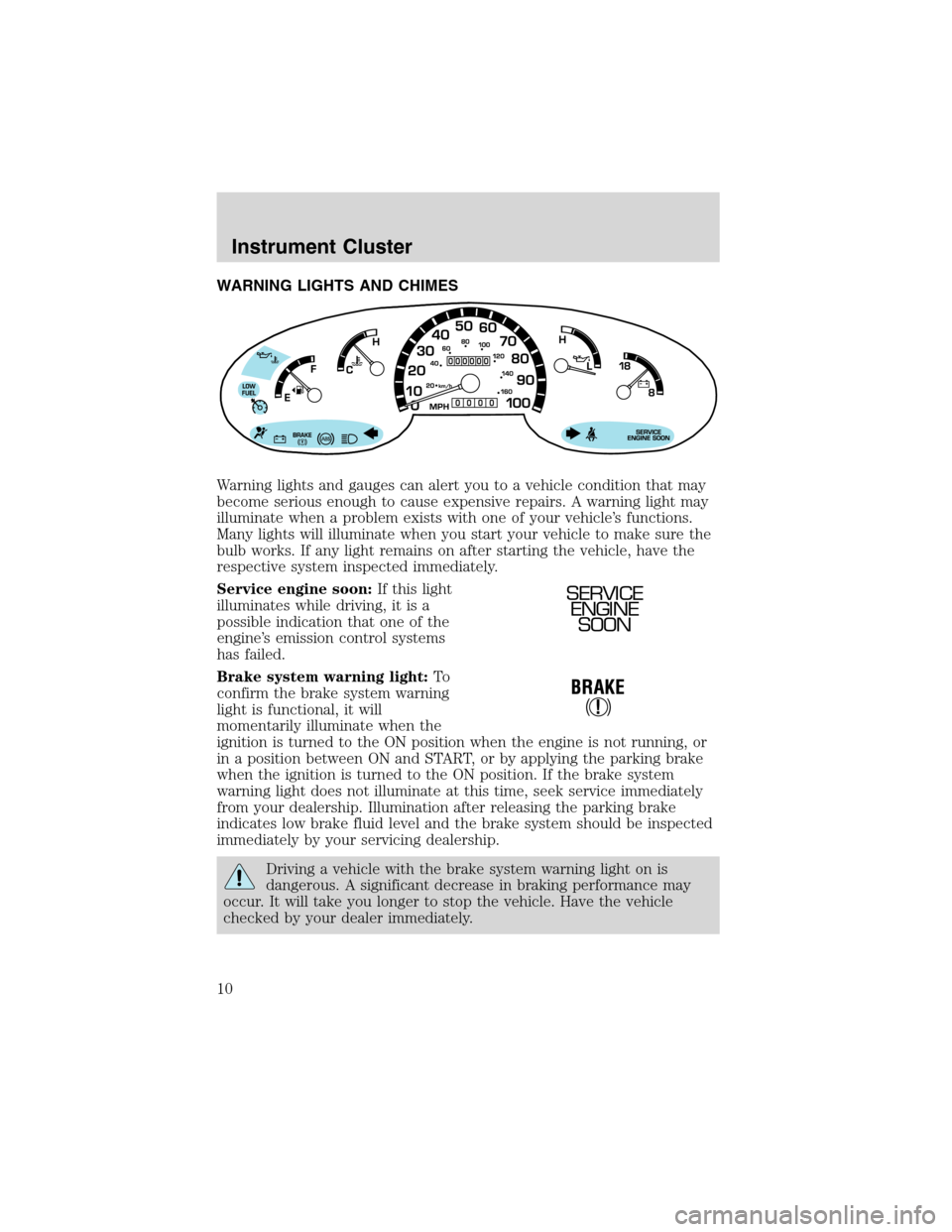
WARNING LIGHTS AND CHIMES
Warning lights and gauges can alert you to a vehicle condition that may
become serious enough to cause expensive repairs. A warning light may
illuminate when a problem exists with one of your vehicle’s functions.
Many lights will illuminate when you start your vehicle to make sure the
bulb works. If any light remains on after starting the vehicle, have the
respective system inspected immediately.
Service engine soon:If this light
illuminates while driving, it is a
possible indication that one of the
engine’s emission control systems
has failed.
Brake system warning light:To
confirm the brake system warning
light is functional, it will
momentarily illuminate when the
ignition is turned to the ON position when the engine is not running, or
in a position between ON and START, or by applying the parking brake
when the ignition is turned to the ON position. If the brake system
warning light does not illuminate at this time, seek service immediately
from your dealership. Illumination after releasing the parking brake
indicates low brake fluid level and the brake system should be inspected
immediately by your servicing dealership.
Driving a vehicle with the brake system warning light on is
dangerous. A significant decrease in braking performance may
occur. It will take you longer to stop the vehicle. Have the vehicle
checked by your dealer immediately.
SERVICE
ENGINE
SOON
Instrument Cluster
10
Page 12 of 232
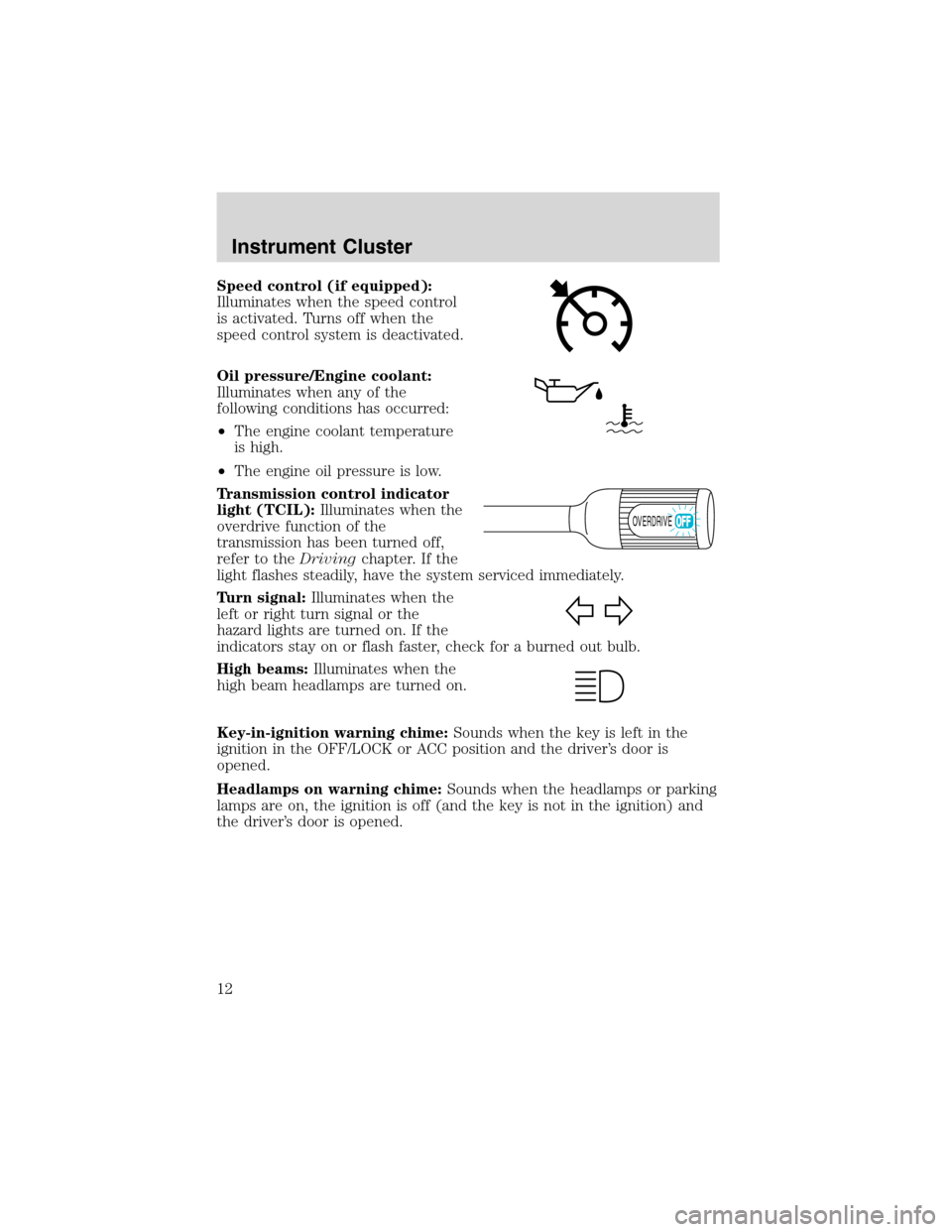
Speed control (if equipped):
Illuminates when the speed control
is activated. Turns off when the
speed control system is deactivated.
Oil pressure/Engine coolant:
Illuminates when any of the
following conditions has occurred:
•The engine coolant temperature
is high.
•The engine oil pressure is low.
Transmission control indicator
light (TCIL):Illuminates when the
overdrive function of the
transmission has been turned off,
refer to theDrivingchapter. If the
light flashes steadily, have the system serviced immediately.
Turn signal:Illuminates when the
left or right turn signal or the
hazard lights are turned on. If the
indicators stay on or flash faster, check for a burned out bulb.
High beams:Illuminates when the
high beam headlamps are turned on.
Key-in-ignition warning chime:Sounds when the key is left in the
ignition in the OFF/LOCK or ACC position and the driver’s door is
opened.
Headlamps on warning chime:Sounds when the headlamps or parking
lamps are on, the ignition is off (and the key is not in the ignition) and
the driver’s door is opened.
OVERDRIVE
Instrument Cluster
12
Page 176 of 232
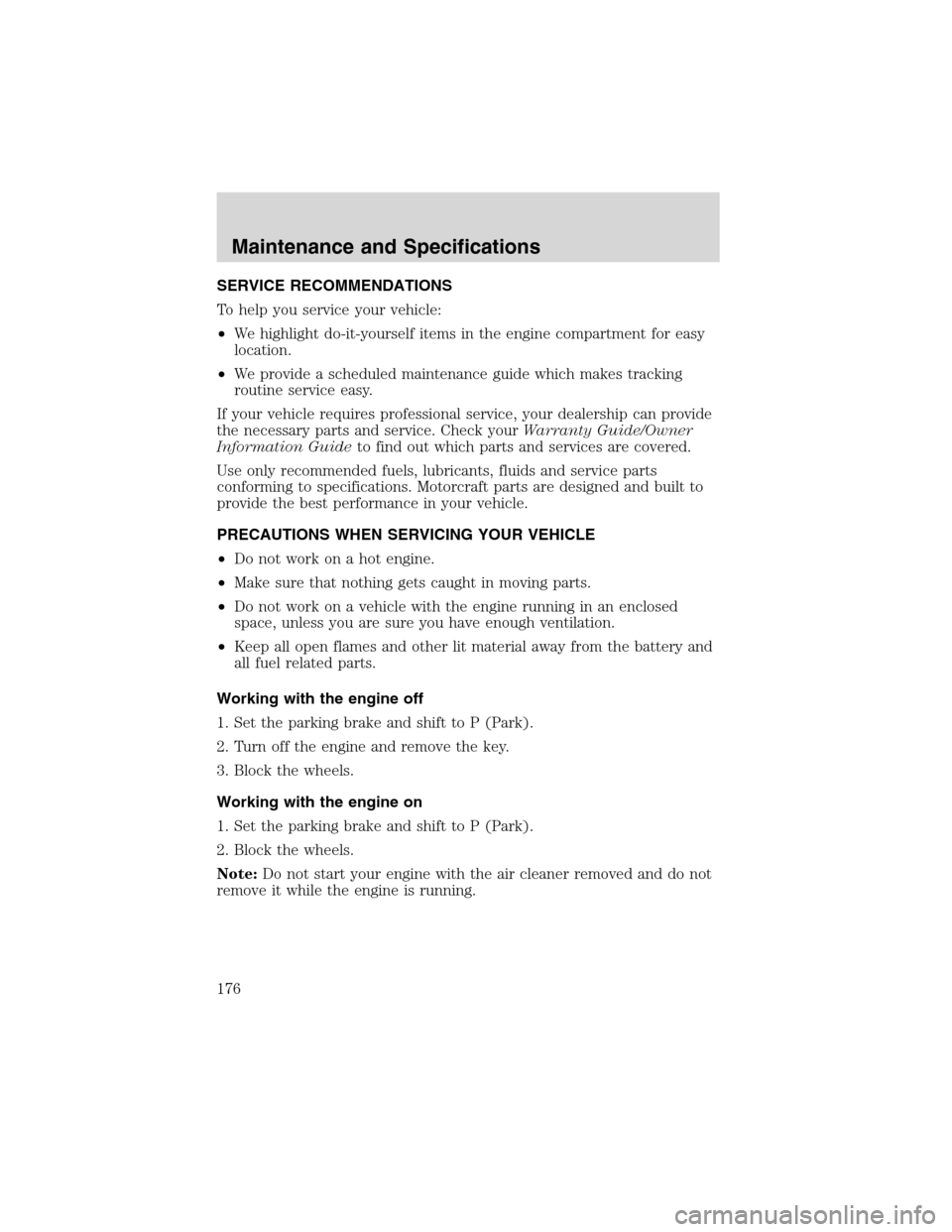
SERVICE RECOMMENDATIONS
To help you service your vehicle:
•We highlight do-it-yourself items in the engine compartment for easy
location.
•We provide a scheduled maintenance guide which makes tracking
routine service easy.
If your vehicle requires professional service, your dealership can provide
the necessary parts and service. Check yourWarranty Guide/Owner
Information Guideto find out which parts and services are covered.
Use only recommended fuels, lubricants, fluids and service parts
conforming to specifications. Motorcraft parts are designed and built to
provide the best performance in your vehicle.
PRECAUTIONS WHEN SERVICING YOUR VEHICLE
•Do not work on a hot engine.
•Make sure that nothing gets caught in moving parts.
•Do not work on a vehicle with the engine running in an enclosed
space, unless you are sure you have enough ventilation.
•Keep all open flames and other lit material away from the battery and
all fuel related parts.
Working with the engine off
1. Set the parking brake and shift to P (Park).
2. Turn off the engine and remove the key.
3. Block the wheels.
Working with the engine on
1. Set the parking brake and shift to P (Park).
2. Block the wheels.
Note:Do not start your engine with the air cleaner removed and do not
remove it while the engine is running.
Maintenance and Specifications
176
Page 193 of 232
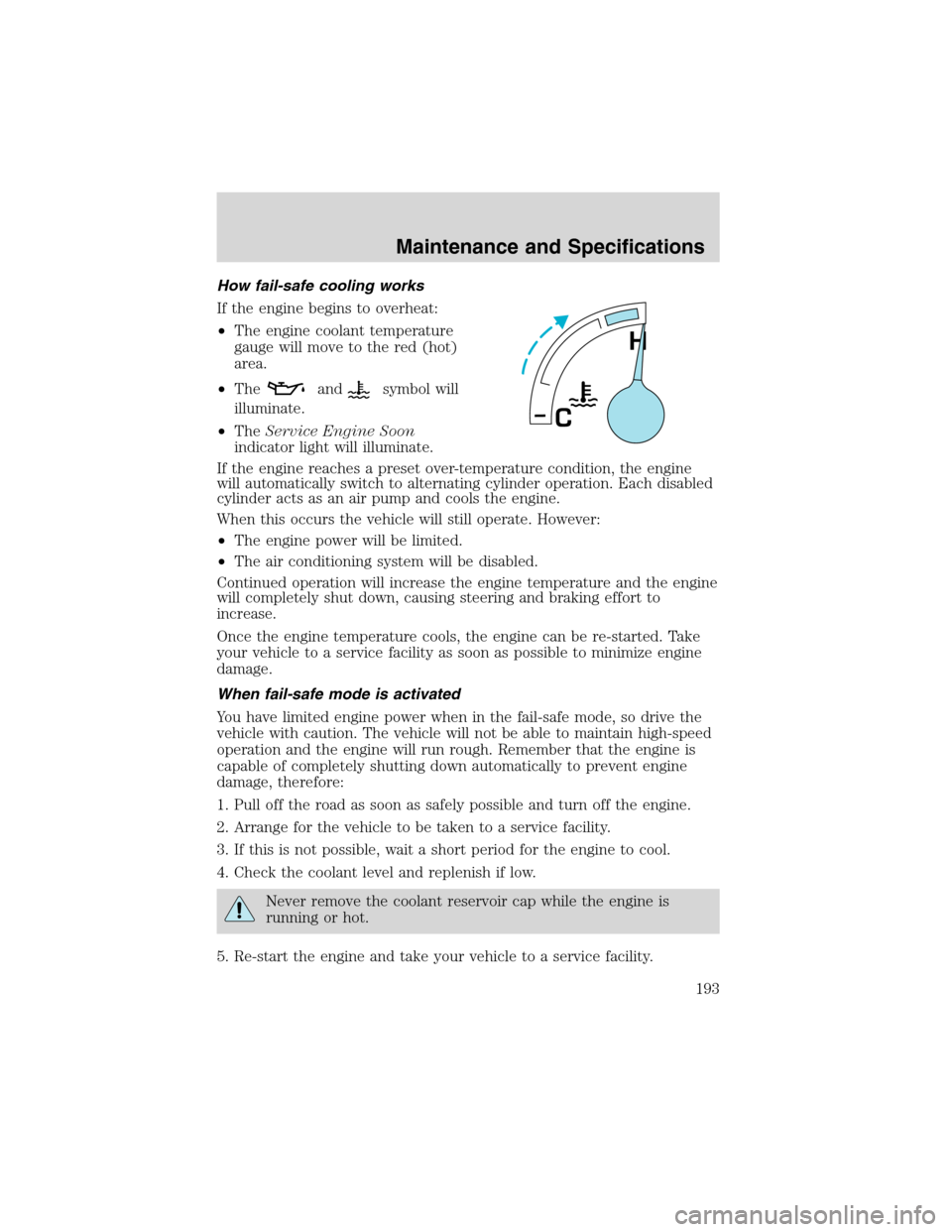
How fail-safe cooling works
If the engine begins to overheat:
•The engine coolant temperature
gauge will move to the red (hot)
area.
•The
andsymbol will
illuminate.
•TheService Engine Soon
indicator light will illuminate.
If the engine reaches a preset over-temperature condition, the engine
will automatically switch to alternating cylinder operation. Each disabled
cylinder acts as an air pump and cools the engine.
When this occurs the vehicle will still operate. However:
•The engine power will be limited.
•The air conditioning system will be disabled.
Continued operation will increase the engine temperature and the engine
will completely shut down, causing steering and braking effort to
increase.
Once the engine temperature cools, the engine can be re-started. Take
your vehicle to a service facility as soon as possible to minimize engine
damage.
When fail-safe mode is activated
You have limited engine power when in the fail-safe mode, so drive the
vehicle with caution. The vehicle will not be able to maintain high-speed
operation and the engine will run rough. Remember that the engine is
capable of completely shutting down automatically to prevent engine
damage, therefore:
1. Pull off the road as soon as safely possible and turn off the engine.
2. Arrange for the vehicle to be taken to a service facility.
3. If this is not possible, wait a short period for the engine to cool.
4. Check the coolant level and replenish if low.
Never remove the coolant reservoir cap while the engine is
running or hot.
5. Re-start the engine and take your vehicle to a service facility.
H
C
Maintenance and Specifications
193
Page 202 of 232
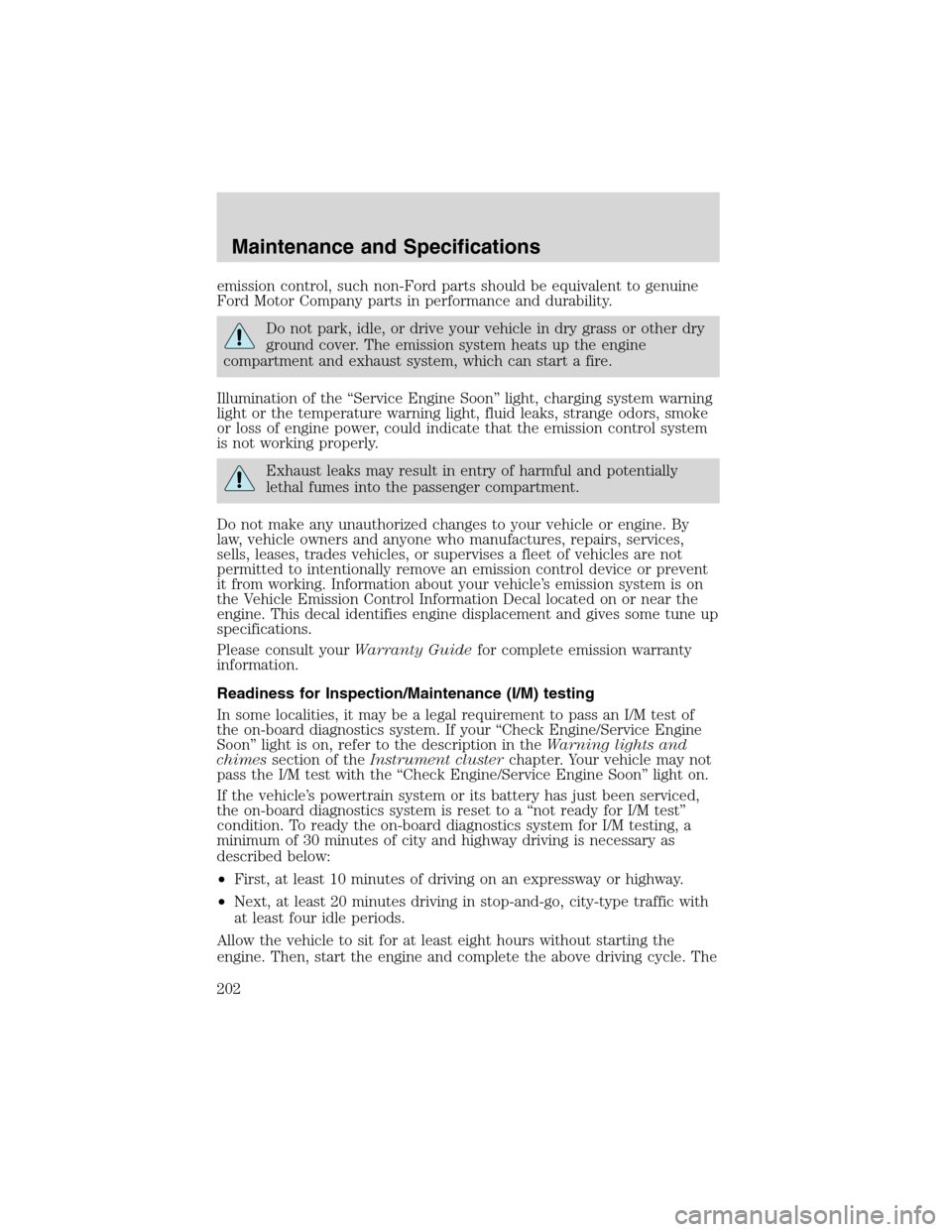
emission control, such non-Ford parts should be equivalent to genuine
Ford Motor Company parts in performance and durability.
Do not park, idle, or drive your vehicle in dry grass or other dry
ground cover. The emission system heats up the engine
compartment and exhaust system, which can start a fire.
Illumination of the“Service Engine Soon”light, charging system warning
light or the temperature warning light, fluid leaks, strange odors, smoke
or loss of engine power, could indicate that the emission control system
is not working properly.
Exhaust leaks may result in entry of harmful and potentially
lethal fumes into the passenger compartment.
Do not make any unauthorized changes to your vehicle or engine. By
law, vehicle owners and anyone who manufactures, repairs, services,
sells, leases, trades vehicles, or supervises a fleet of vehicles are not
permitted to intentionally remove an emission control device or prevent
it from working. Information about your vehicle’s emission system is on
the Vehicle Emission Control Information Decal located on or near the
engine. This decal identifies engine displacement and gives some tune up
specifications.
Please consult yourWarranty Guidefor complete emission warranty
information.
Readiness for Inspection/Maintenance (I/M) testing
In some localities, it may be a legal requirement to pass an I/M test of
the on-board diagnostics system. If your“Check Engine/Service Engine
Soon”light is on, refer to the description in theWarning lights and
chimessection of theInstrument clusterchapter. Your vehicle may not
pass the I/M test with the“Check Engine/Service Engine Soon”light on.
If the vehicle’s powertrain system or its battery has just been serviced,
the on-board diagnostics system is reset to a“not ready for I/M test”
condition. To ready the on-board diagnostics system for I/M testing, a
minimum of 30 minutes of city and highway driving is necessary as
described below:
•First, at least 10 minutes of driving on an expressway or highway.
•Next, at least 20 minutes driving in stop-and-go, city-type traffic with
at least four idle periods.
Allow the vehicle to sit for at least eight hours without starting the
engine. Then, start the engine and complete the above driving cycle. The
Maintenance and Specifications
202
Page 227 of 232
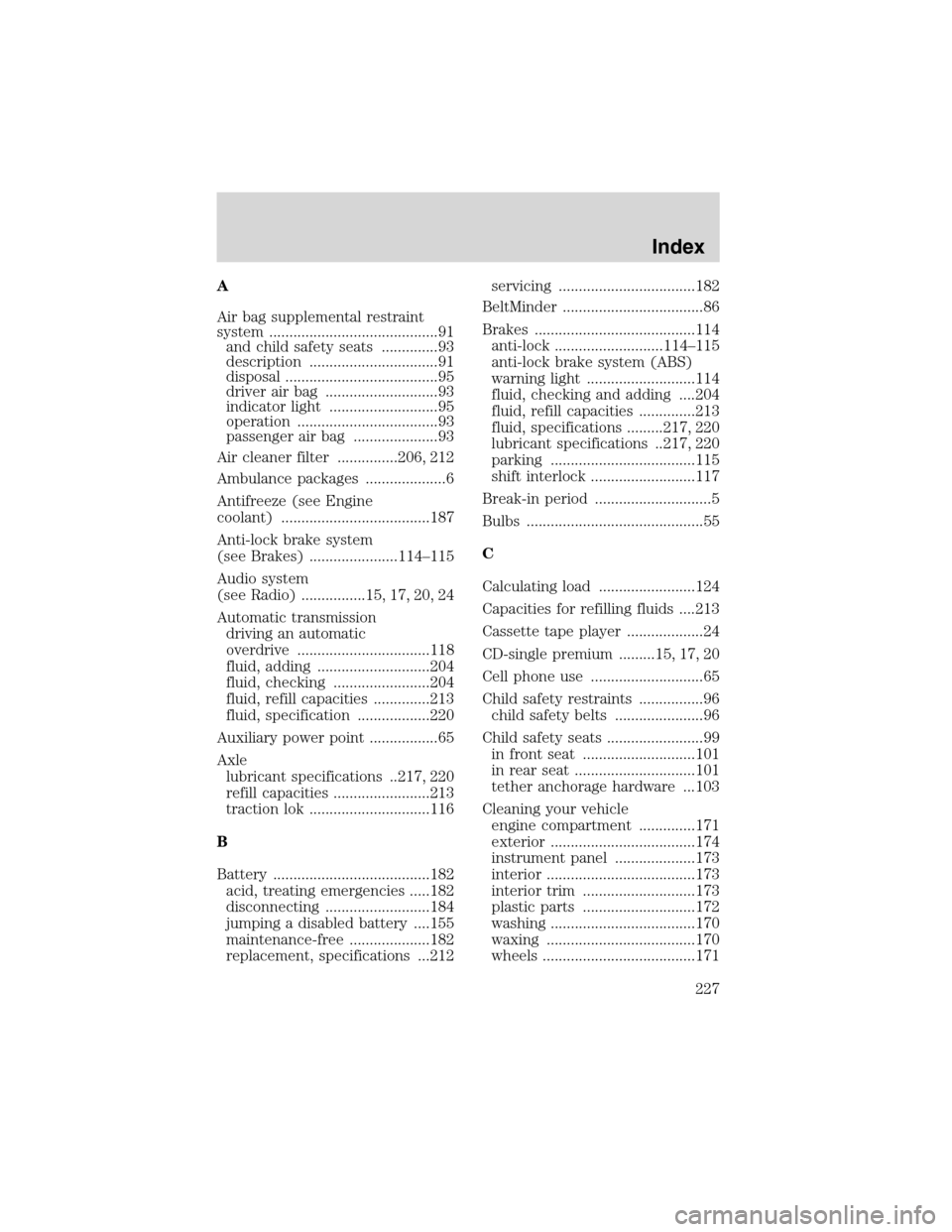
A
Air bag supplemental restraint
system ..........................................91
and child safety seats ..............93
description ................................91
disposal ......................................95
driver air bag ............................93
indicator light ...........................95
operation ...................................93
passenger air bag .....................93
Air cleaner filter ...............206, 212
Ambulance packages ....................6
Antifreeze (see Engine
coolant) .....................................187
Anti-lock brake system
(see Brakes) ......................114–115
Audio system
(see Radio) ................15, 17, 20, 24
Automatic transmission
driving an automatic
overdrive .................................118
fluid, adding ............................204
fluid, checking ........................204
fluid, refill capacities ..............213
fluid, specification ..................220
Auxiliary power point .................65
Axle
lubricant specifications ..217, 220
refill capacities ........................213
traction lok ..............................116
B
Battery .......................................182
acid, treating emergencies .....182
disconnecting ..........................184
jumping a disabled battery ....155
maintenance-free ....................182
replacement, specifications ...212servicing ..................................182
BeltMinder ...................................86
Brakes ........................................114
anti-lock ...........................114–115
anti-lock brake system (ABS)
warning light ...........................114
fluid, checking and adding ....204
fluid, refill capacities ..............213
fluid, specifications .........217, 220
lubricant specifications ..217, 220
parking ....................................115
shift interlock ..........................117
Break-in period .............................5
Bulbs ............................................55
C
Calculating load ........................124
Capacities for refilling fluids ....213
Cassette tape player ...................24
CD-single premium .........15, 17, 20
Cell phone use ............................65
Child safety restraints ................96
child safety belts ......................96
Child safety seats ........................99
in front seat ............................101
in rear seat ..............................101
tether anchorage hardware ...103
Cleaning your vehicle
engine compartment ..............171
exterior ....................................174
instrument panel ....................173
interior .....................................173
interior trim ............................173
plastic parts ............................172
washing ....................................170
waxing .....................................170
wheels ......................................171
Index
227
Page 230 of 232
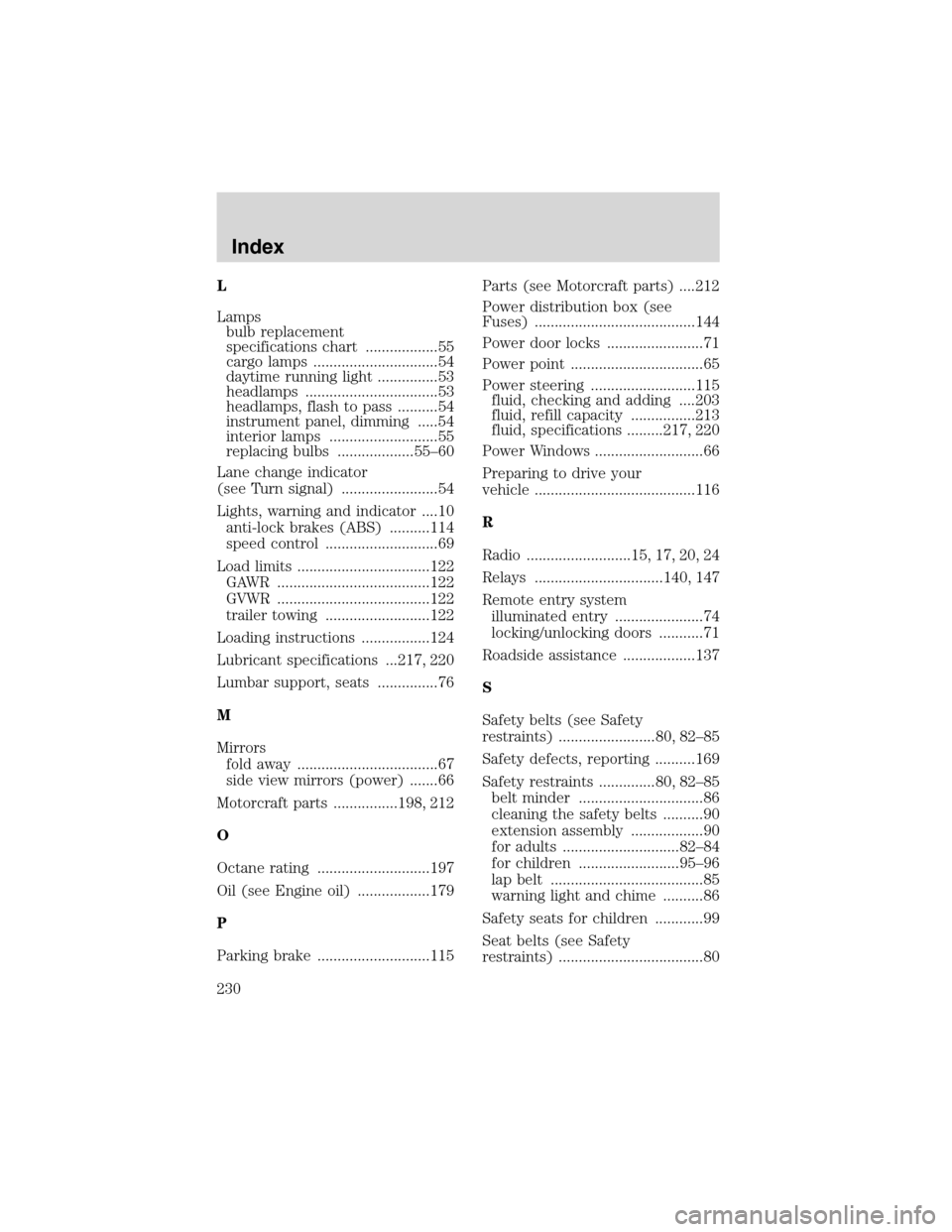
L
Lamps
bulb replacement
specifications chart ..................55
cargo lamps ...............................54
daytime running light ...............53
headlamps .................................53
headlamps, flash to pass ..........54
instrument panel, dimming .....54
interior lamps ...........................55
replacing bulbs ...................55–60
Lane change indicator
(see Turn signal) ........................54
Lights, warning and indicator ....10
anti-lock brakes (ABS) ..........114
speed control ............................69
Load limits .................................122
GAWR ......................................122
GVWR ......................................122
trailer towing ..........................122
Loading instructions .................124
Lubricant specifications ...217, 220
Lumbar support, seats ...............76
M
Mirrors
fold away ...................................67
side view mirrors (power) .......66
Motorcraft parts ................198, 212
O
Octane rating ............................197
Oil (see Engine oil) ..................179
P
Parking brake ............................115Parts (see Motorcraft parts) ....212
Power distribution box (see
Fuses) ........................................144
Power door locks ........................71
Power point .................................65
Power steering ..........................115
fluid, checking and adding ....203
fluid, refill capacity ................213
fluid, specifications .........217, 220
Power Windows ...........................66
Preparing to drive your
vehicle ........................................116
R
Radio ..........................15, 17, 20, 24
Relays ................................140, 147
Remote entry system
illuminated entry ......................74
locking/unlocking doors ...........71
Roadside assistance ..................137
S
Safety belts (see Safety
restraints) ........................80, 82–85
Safety defects, reporting ..........169
Safety restraints ..............80, 82–85
belt minder ...............................86
cleaning the safety belts ..........90
extension assembly ..................90
for adults .............................82–84
for children .........................95–96
lap belt ......................................85
warning light and chime ..........86
Safety seats for children ............99
Seat belts (see Safety
restraints) ....................................80
Index
230